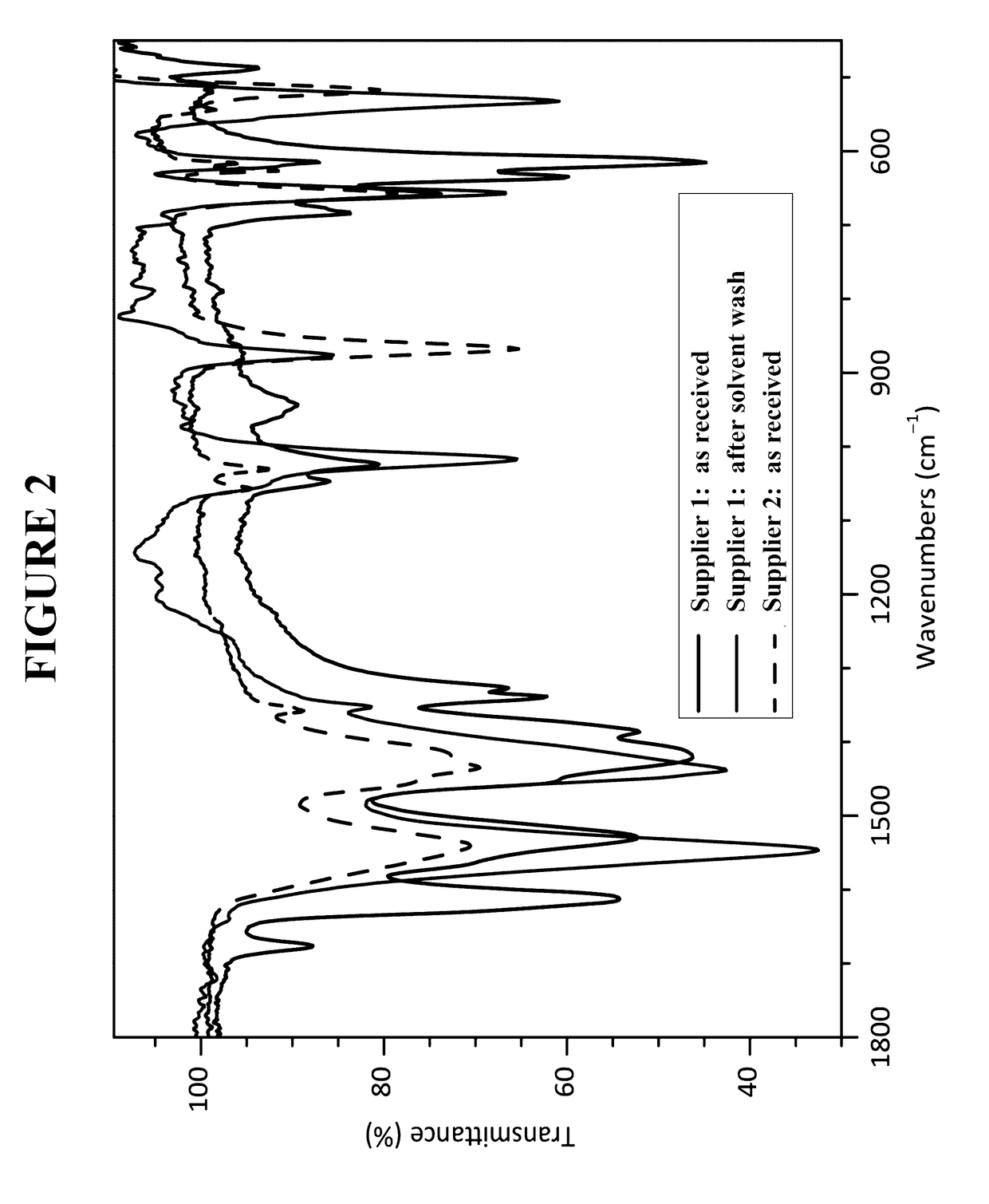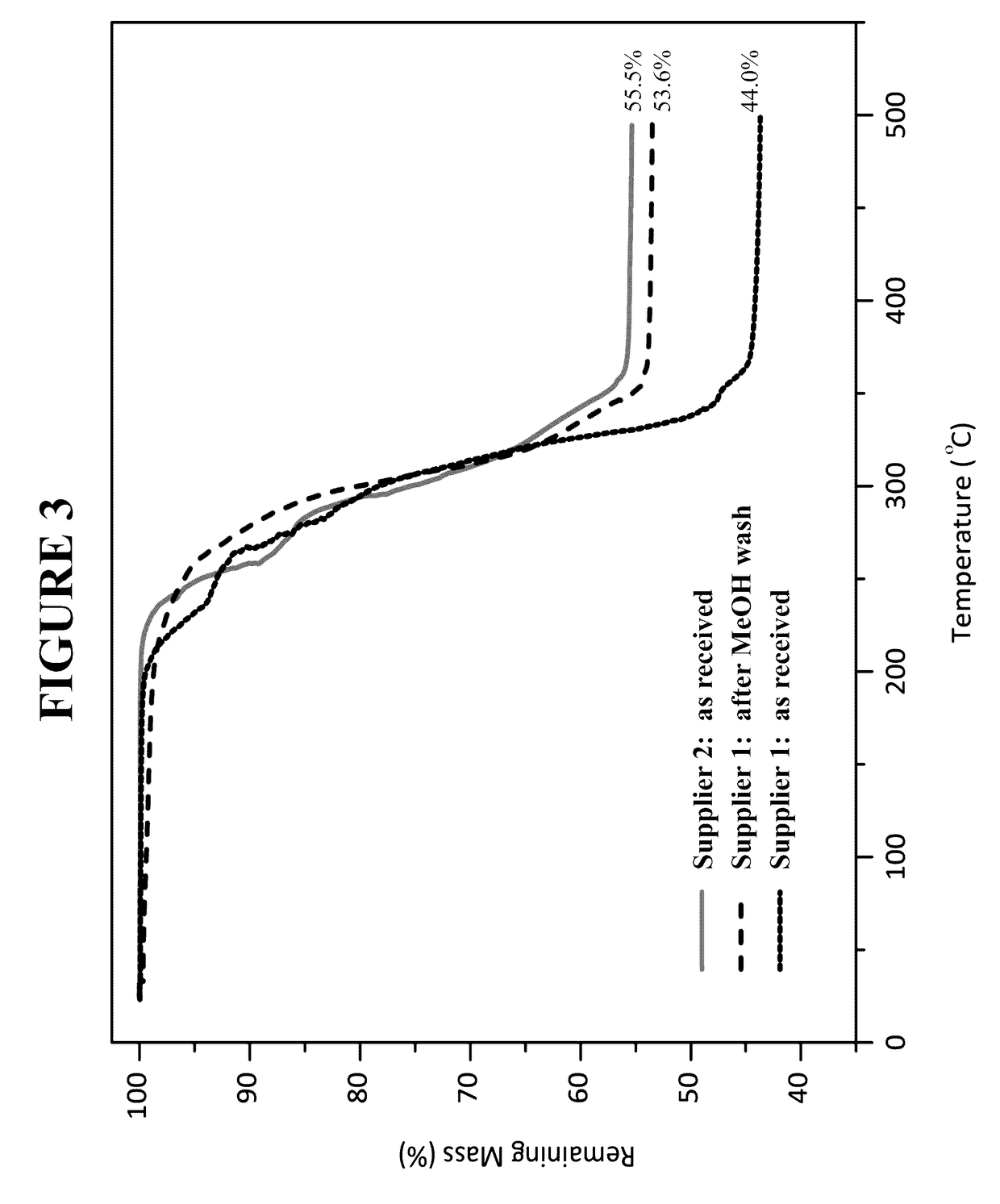Use of heteroleptic indium hydroxides as precursors for inp nanocrystals
a technology of heteroleptic indium hydroxide and nanocrystals, applied in the field of nanostructure synthesis, can solve the problems of increasing production costs, affecting the ability of the one in the art to know and control, and the synthetic method will not produce consistent nanocrystal products
- Summary
- Abstract
- Description
- Claims
- Application Information
AI Technical Summary
Benefits of technology
Problems solved by technology
Method used
Image
Examples
example 1
Control Reaction for Preparation of In(O2CCH3)2OH
[0247]In the glovebox, three 500 mg samples (each from a different lot) of indium acetate (Indium Corporation, Utica, N.Y.) were weighed. To each sample was added 10 mL of anhydrous diethyl ether. The sample was vigorously shaken. Outside the glovebox, the samples were filtered through a M-porosity filtration / fritted funnel to collect the solids. In order to rinse the vials, hexanes were added and the slurry that formed was filtered. The solids were dried under dynamic vacuum for between 5 to 10 minutes. Each solid was analyzed by Fourier transform infrared spectroscopy (FTIR).
[0248]In the glovebox, three 500 mg samples of indium acetate (Indium Corporation, Utica, N.Y.) were weighed. To each sample was added 10 mL of anhydrous diethyl ether and 1 mL of deionized water. The samples were vigorously shaken. Outside the glovebox, the samples were filtered through a M-porosity filtration / fritted funnel to collect the solids. In order to r...
example 2
Synthesis of In(O2CCH3)2OH on a Large Scale
[0251]In the glovebox, 35 g (0.120 mol, 1 equivalent) of commercially available indium acetate (Indium Corporation, Utica, N.Y.) was weighed and transferred into a 500 mL (2.89 mol, 24.1 equivalents) round-bottomed flask equipped with a stir bar. At 20° C., 300 mL (1.67 mol, 13.9 equivalents) of anhydrous diethyl ether was added to the flask followed by drop-wise addition of 30 mL of deionized water with stirring. The addition took approximately 15 minutes to complete. A granular white solid formed upon addition in contrast to the fine powder indium acetate starting material. After addition, the reaction mixture was stirred for 1 hour. The granular solid was scraped off the sides of the reaction flask followed by 30 additional minutes of stirring for a total of 90 minutes. The mixture was filtered through a M-porosity filtration / fritted funnel. The solid were washed with diethyl ether (3×150 mL) and dried at 20° C. under vacuum for 2 hours....
example 3
Reaction of In(O2CCH3)2OH and Lauric Acid
[0253]A 100 mL three-necked round-bottomed flask was oven heated for 30 minutes followed by insertion of a thermocouple port, a septum, and a gas adapter. While hot, the flask was evacuated. Once the round-bottomed flask cooled to room temperature, nitrogen was allowed to flow into the flask followed by the addition of 2.5 grams (10 mmol, 1 equivalent) In(O2CCH3)2OH and 4.3 grams (21.5 mmol, 2.15 equivalents) of lauric acid. The flask was heated to 50° C. for 1 hour resulting in melting of some of the solids with additional solid remaining on the upper walls of the flask. The temperature was increased to 110° C. for 30 minutes followed by an increase in the temperature to 150° C. Once a temperature of 150° C. was reached, nitrogen was forced through the solution using a silicon oil bubbler. During the 30 minutes that the temperature was maintained at 150° C., some white fumes exit. After 30 minutes, the flask was dried under dynamic vacuum fo...
PUM
| Property | Measurement | Unit |
|---|---|---|
| Temperature | aaaaa | aaaaa |
| Temperature | aaaaa | aaaaa |
| Temperature | aaaaa | aaaaa |
Abstract
Description
Claims
Application Information
 Login to View More
Login to View More - R&D
- Intellectual Property
- Life Sciences
- Materials
- Tech Scout
- Unparalleled Data Quality
- Higher Quality Content
- 60% Fewer Hallucinations
Browse by: Latest US Patents, China's latest patents, Technical Efficacy Thesaurus, Application Domain, Technology Topic, Popular Technical Reports.
© 2025 PatSnap. All rights reserved.Legal|Privacy policy|Modern Slavery Act Transparency Statement|Sitemap|About US| Contact US: help@patsnap.com



